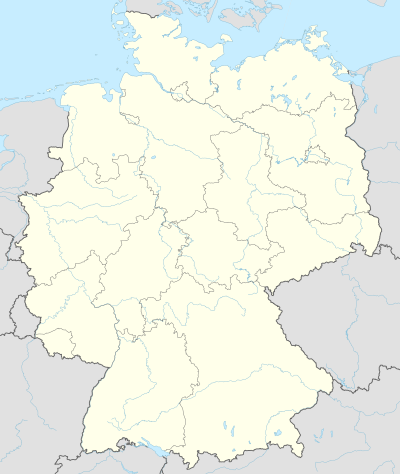|
2012–13 Rugby-Bundesliga
The 2012–13 Rugby-Bundesliga was the 42nd edition of this competition and the 93rd edition of the German rugby union championship. In the Rugby-Bundesliga, twenty-two teams played in, initially, four regional divisions, the first stage of the competition. The season started on 25 August 2012 and finished with the championship final on 15 June 2013, interrupted by a winter break from 25 November to 3 March.[1][2] The regular season finished on Wednesday 1 May and the play-offs started on the following weekend, 4 May, and the German championship final was held on 15 June 2013.[3] The defending champions were Heidelberger RK who defeated TV Pforzheim in the 2012 final to take out its eights championship and third in a row. Heidelberger RK took out the national championship once more, remaining unbeaten all season and defeating local rival SC Neuenheim 41–10 in the final. OverviewThe league has been radically modified from the 2011–12 season. In 2011–12 the league operated with ten teams playing in a single division in a home-and-away format with semi-finals and a final at the end.[4] In 2012–13 the league has been expanded, initially to twenty-four teams, which were to play in four regional divisions of six teams each. In those each team would play the others in its division just once. However, two teams resigned from the league before the start of the season, reducing the number of clubs to twenty-two. The Berlin Grizzlies of the eastern division opted to form a team with the reserve side of USV Potsdam Rugby and play in the 2nd Rugby-Bundesliga instead.[5] DRC Hannover withdrew from the northern division just before the first game of the season, suffering from a lack of first team players and entered the tier three Rugby-Regionalliga instead for 2012–13.[6] The first stage of the competition, the Vorrunde, will finish on 3 October 2012 after which the second stage will start, the Qualifikationsphase, in which the top four teams each from the southern and the western group play each other in one group while the top teams from the north and east play each other in another.[7] The finals series will be expanded from four to eight teams. The six teams not qualified for the Qualifikationsphase will enter the DRV-Pokal, the German rugby union cup, together with the top eight teams of the 2nd Bundesliga.[8] The 2nd Bundesliga teams not qualified for the DRV-Pokal will play for the Liga Pokal.[9] In the second stage the teams within a group will play each other in a home-and-away format, with the teams that already played each other in the first stage carrying over those results. All sixteen clubs will qualify for the knock-out stage.[9] One of the main aims of the reform was to reduce the number of kilometres traveled by individual teams and therefore reduce the travel expenses. Additionally, the 2nd Bundesliga was also expanded to 24 teams.[10][11][12] Because of the enlargement of the league from ten to twenty-two (initially twenty-four) teams no club was relegated after the 2011–12 season but twelve clubs promoted:
Two clubs finished the regular season unbeaten, DSV 78 Hannover and Heidelberger RK. Of the sixteen clubs qualified for the play-offs three decided to cancel their first round match, the three bottom placed clubs in the north east, Berliner SV 92, Victoria Linden and USV Potsdam, with all three games awarded 50-0 to the opposition.[13] The quarter finals saw the south western clubs dominate with all four advancing teams being from that division and all north eastern clubs being knocked out.[14] The semi finals were heavily affected by bad weather, with both games, to be held in Heidelberg, being canceled and rescheduled.[15] The final saw Heidelberger RK defeat SC Neuenheim 41–10 to take out its ninth national championship and fourth consecutive one. Bundesliga tables & resultsFirst stageIn the first stage twenty-two clubs played in four groups. Within each group each team played the other just once. The best four teams in each group advanced to the second stage.[9] NorthThe table and results of the division:[16][17]
EastThe table and results of the division:[18][19]
WestThe table and results of the division:[20][21]
SouthThe table and results of the division:[24][25]
Second stageIn the second stage sixteen clubs played in two groups of eight clubs each. Within each group each team played the others home and away except for the match-ups that already had been played in the first round. The results of those were carried over. All teams in this stage qualified for the play-offs and were seeded according to the final standings.[9] North-EastThe table and results of the division:[26]
South-WestThe table and results of the division:[27]
Play-off stageIn the play-offs the sixteen qualified clubs play a knock-out competition in single game format with the winner moving on to the next round. In the first round of the play-off the north-east division clubs play against the south-west division clubs.[9] The play-offs began on 4 May with the round of sixteen, followed by the quarter-finals on 25 May, semi finals on 1 June and the German championship final on 15 June 2013.[3] However, both semi final games, to be held in Heidelberg, had to be postponed because of bad weather,[15] and rescheduled for 12 June.
References
External links |
|||||||||||||||||||||||||||||||||||||||||||||||||||||||||||||||||||||||||||||||||||||||||||||||||||||||||||||||||||||||||||||||||||||||||||||||||||||||||||||||||||||||||||||||||||||||||||||||||||||||||||||||||||||||||||||||||||||||||||||||||||||||||||||||||||||||||||||||||||||||||||||||||||||||||||||||||||||||||||||||||||||||||||||||||||||||||||||||||||||||||||||||||||||||||||||||||||||||||||||||||||||||||||||||||||||||||||||||||||||||||||||||||||||||||||||||||||||||||||||||||||||||||||||||||||||||||||||||||||||||||||||||||||||||||||||||||||||||||||||||||||||||||||||||||||||||||||||||||||||||||||||||||||||||||||||||||||||||||||||||||||||||||||||||||||||||||||||||||||||||||||||||||||||||||||||||||||||||||||||||||||||||||||||||||||||||||||||||||||||||||||||||||||||||||||||||||||||||||||||||||||||||||||||||||||||||||||||||||||||||||||||||||||||||||||||||||||||||||||||||||||||||||||||||||||||||||||||||||||||||||||||||||||||||||||||||||||||||||||||||||||||||||||||||||||||||||||||||||||||||
Portal di Ensiklopedia Dunia
